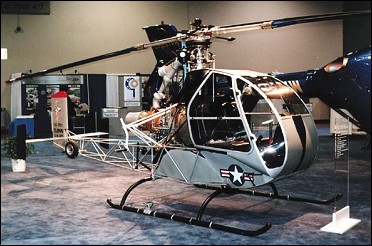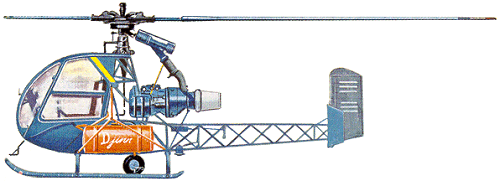
| Sud-Ouest SO.1221 "Djinn" 1957 |  |
 |

| Sud-Ouest SO.1221 "Djinn" 1957 |  |
 |
|
The Djinn was the world's first production helicopter to make use of the 'cold jet' principle of propulsion. The term 'cold jet' indicates simply that compressed air from the gas turbine engine is ducted through channels inside the rotor blades and expelled through nozzles at their tips without further combustion; the air itself is in fact warm enough to eliminate the need for other means of de-icing the blades. No tail rotor is fitted, the aircraft having two outrigged fins and a large central rudder that is situated in the line of the residual thrust exhaust from the engine to provide directional control. The Djinn is a highly manoeuvrable little machine, and has been described as 'lenient where flying faults are concerned'. The Djinn's career began with two single-seat SO.1220 prototypes, F-WGVO and F-WGZX, the first of which made its maiden flight on 2 January 1953. These were both intended primarily to prove the rotor and propulsion systems, and were open-framework machines without enclosed cabins; F-WGVO was later fitted experimentally with agricultural spray booms. On 16 December 1953 the first of five 2-seat SO.1221 prototypes was flown, having a fully enclosed cabin and an all-up weight of 600kg, and on 29 December this aircraft established a new altitude record in its class of 4789m. Twenty-two pre-series SO. 1221's were then built, primarily for evaluation for the French Army, and the first of these was flown on 23 September 1954. Three machines from this batch were evaluated by the U.S. Army, under the designation YHO-1. Chief customer for the Djinn has been France's Aviation Legere de l'Armee de Terre, which received one hundred of the one hundred and fifty production Djinns completed up to 1961, and still had about half of these in service in mid-1967. Six were also delivered to the Federal German Heeresfliegerei. The military Djinns operate at a slightly higher gross weight - 800kg - than the civil models. One was used in France for the first experiments in launching Nord SS.10 anti-tank missiles from a helicopter, but the Djinn's main military functions have been those of observation, liaison, training and (with one pilot and two external litters) casualty evacuation. Between forty and fifty civil Djinns are currently active in ten countries, most of them in an agricultural role, for which Sud-Aviation offered renewed conversion facilities in 1965. The so-called 'agricopter' version of the Djinn can carry up to 200 litres of liquid chemical in twin tanks, and is fitted with lateral spray bars for the spraying, dusting or 'fogging' of crops with fertilisers or pesticides. K.Munson "Helicopters And Other Rotorcraft Since 1907", 1968
The experience acquired by Sud-Ouest in building its two prototypes of the Ariel led to the SO.1221 Djinn. This was preceded by two SO.1220 single-seat prototypes, the first of which flew on 2 January 1953. The first definitive Model SO.1221 did not fly until the end of that year. It had an enclosed cabin, two side-by-side seats and an open-framework tail boom. The French Army promptly ordered 22 for service trials and by the end of 1960 more than 180 had been built, 100 of which were bought by the French Army and Air Force. In the Djinn, torque reaction was offset by a turbine jet deflector mounted at the tail, which could be rotated to act as a rudder as well; two smaller fixed surfaces mounted farther out acted as stabilizers. The Djinn could take off and land quite easily on the back of an ordinary lorry. Among its many uses, it was widely adopted for agriculture. G.Apostolo "The Illustrated Encyclopedia of Helicopters", 1984  In late 1956 the Army leased three examples of Sud-Ouest's diminutive Model SO.1221 Djinn two-place light turbine helicopter for evaluation in the observation role. The Djinn, which had first flown in December 1953, was already in service with the French Army as an observation craft and its success in that role, coupled with its relatively low per-unit cost and fairly basic maintenance requirements, piqued the Army's interest. The machines obtained by the Army (serials 57-6104 through -6106) were the first helicopters acquired under the new HO (helicopter, observation) classification, and were designated YHO-1. The SO.1221 was of welded steel-tube construction and was powered by an innovative cold-jet propulsion system developed by Sud-Ouest for its earlier Ariel II and III helicopters. In the Djinn this system used a modified Turbomeca Palouste IV engine as a turbo-generator to feed compressed air through the rotor shaft to ejectors built into the tips of each rotor blade; this provided the benefits of a ramjet without the weight penalties imposed by blade-tip combustion chambers. The Djinn had no tail rotor, directional stability being achieved by directing the engine's exhaust onto a large central rudder set between small endplate fins at the end of the aircraft's cantilever tail. The craft's small and rather spartan two-seat cockpit was surrounded by a sectioned bubble-type enclosure and transparent side doors, which combined to provide excellent visibility forward and to both sides. Cockpit instrumentation was quite basic in the standard SO.1221, and the three YOH-1s were consequently fitted with additional U.S. military-standard avionics and communications equipment for their Army evaluation. The Djinn's landing gear was of the skid type, with small retractable wheels to facilitate ground handling. The Army's engineering and operational evaluation of the YOH-1 found the aircraft to be well built, relatively easy to maintain under field conditions, and an exceptional observation platform. The Djinn was not adopted for service use, however, primarily because the Army faced continuing budgetary constraints and some domestic political opposition to the procurement of French, rather than American (or Canadian) aircraft. In early 1958 all three YOH-1s were returned to Sud-Ouest for ultimate delivery to the French Army. S.Harding "U.S.Army Aircraft since 1947", 1990
Experience with the experimental Ariel helicopters brought conviction that it should be possible to drive a helicopter rotor by compressed air jets at the blade tips, avoiding the added weight of fuel and ignition systems that had been required by the tip jets of the Ariel aircraft. Thus, on 2 January 1953 SNCASO flew, the Sud-Ouest S.O.1220 test vehicle, a simple uncovered structure of welded steel tube carrying a two-blade rotor above it, and with a single exposed seat for its pilot. Its powerplant was a Turbomeca Palouste turbo-compressor producing a large volume of compressed air which, using a similar distribution method to that of the Ariel, was discharged at the blade tips. Testing showed the system to be an improvement upon the tip jets, leading to the construction of five two-seat S.O.1221 prototypes with a fully enclosed cabin, the first of them making its initial flight on 16 December 1953. Just 13 days later this aircraft established a new class altitude record of 4789m. French army interest speeded the construction of 22 pre-production aircraft, most of them for service evaluation, and the first of these was flown on 23 September 1954. Somewhat later, three aircraft from this pre-production batch were acquired by the US Army for evaluation under the designation YHO-1. The French army was enthusiastic about the capability and simplicity of the S.O.1221 Djinn, ordering 100, and these were used for casualty evacuation (with a pilot and two external litters), liaison, observation and training. Another military user was the Federal German army which acquired six. The first production aircraft was flown on 5 January 1956, and French and US certification was gained in April 1958. When production ended in the mid-1960s a total of 178 had been built, exported to about 10 countries. Many were used in an agricultural role, equipped with two tanks to contain liquid chemicals and spray bars for its distribution. By the time that production ended Sud-Ouest had twice changed its name, to Ouest-Aviation on 1 September 1956 and Sud-Aviation on 1 March 1957 when it merged with Sud-Est Aviation; this explains why the Djinn is sometimes recorded as the Quest S.O.1221 or Sud-Aviation S.O.1221. D.Donald "The Complete Encyclopedia of World Aircraft", 1997
|